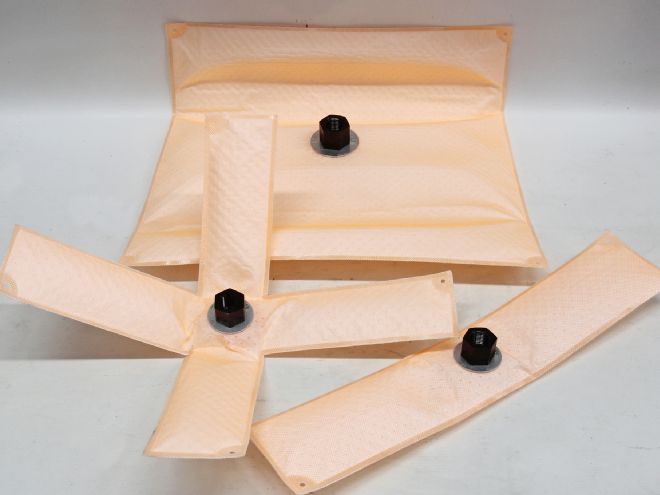
Self-learning electronic fuel injection (EFI) systems have made converting to fuel injection far less painful. This has removed complicated EFI tuning as an excuse not to convert. But a far less celebrated requirement for successful EFI conversion is a reliable fuel delivery system capable of maintaining a constant high-pressure supply of fuel to the injectors. The biggest hurdle to creating a professional fuel delivery system is ensuring there is always a constant supply of fuel to the inlet side of the pump. That would seem simple enough, but for EFI-equipped cars, it’s a challenge. Until now, this required a custom fuel tank with fabricated reservoirs, or adapting late-model factory reservoir pumps into an early Chevy muscle car.
If you just bolt a horizontal electric fuel pump to the outside of a muscle car fuel tank and connect it to the stock pickup along with a return line – that will work – until the fuel level drops below half a tank. Then acceleration-induced fuel tsunamis inside the tank push the fuel away from the pickup. As soon as the pump sucks air, fuel pressure drops to near zero, the engine stumbles badly, and you’re underwhelmed with the results. The quick solution is to always keep the fuel tank near full, which works, but this is hardly a realistic solution. Now, let us introduce you to Holley’s HydraMat.
We first witnessed the HydraMat’s amazing fuel-sponging abilities at a demonstration in Holley’s booth at the SEMA show last year. A small mat rested at the bottom of a clear plastic tank measuring roughly 14x18 inches. There was about a half-gallon of fluid in the tank that was tilted at a severe angle so that only a couple square inches of the mat contacted the fluid. Holley’s Bill Tichenor engaged a fuel pump and “fuel” immediately began exiting and circulating back to the tank.
Tichenor explained that the HydraMat is a patented material that will pull fuel from any location on the mat as long as fuel is in contact while simultaneously closing off the rest of the mat to prevent pulling air into the inlet stream. If you’ve ever tried to pull soda through a straw that has a crack in it above the liquid line, you know that it doesn’t work very well. The HydraMat uses tiny pores to close off any portion of the mat that is not in contact with fuel. This presents an immediate advantage for retrofitting early muscle cars with an EFI system. Even better, Holley says the mat is compatible with most automotive fuels, including gasoline, ethanol, E85, and even methanol. The HydraMat is not compatible with diesel fuel.
The HydraMat forgoes the necessity of a custom reservoir in the tank because it will be able to pick up even the lowest fuel level remaining in the tank. Because of the tremendous variety of potential uses, Holley has created nine different HydraMat configurations, from a single rectangle measuring 15x3 inches to a full-size 15x15-inch mat for large fuel cells.
In the center of each HydraMat is a plastic fitting for either a 3/8- or 1/2-inch NPT fitting. Some of the larger HydraMats use a -10 AN inlet hose fitting. This is important because reducing the inlet restriction is a great way to improve pump efficiency. These fittings allow you to connect the HydraMat to the fuel pump inlet with a simple hose. In addition to the mat operating like a giant sponge, the HydraMat is also an equally large fuel filter. Holley says the mat is essentially a 15-micron pre-filter over its entire surface so no additional pre-filter should be used. Holley’s testing indicates the mat should be capable of a life expectancy in a typical street car of six years or 60,000 miles. In off-road applications where dirt is an issue, the service life will be reduced.
Each corner of the HydraMat is also fitted with a 5/32-inch mounting hole. Available separately, Holley offers slick magnetic mounts for steel tanks that will retain the HydraMat in the tank with small 6-32 machine screw pins. For polypropylene tanks, you have the option of strong magnets that can be placed on the outside of the tank that will adhere to the inner magnets to retain the HydraMat. A third option, for aluminum tanks is a Click Bond kit using epoxy that glue mounts to the bottom of the tank.
Perhaps the biggest concern is installing the HydraMat in an OE fuel tank. For Chevy muscle cars, this is tight, but not impossible. The standard sending unit hole measures 1.900-inch diameter, so it’s possible to squeeze the PN 16-105 rectangular HydraMat through the stock sending unit hole in the tank even with a 3/8-inch fitting and rubber hose attached to the mat. The key is to attach everything to the mat, including the magnetic mounts, and then carefully squeeze the mat into the tank.
For later-model tanks or aftermarket fuel cells, the installation will be much easier. Generally, these tanks offer larger inlets that allow easier access to both install and position the HydraMat in the tank. Holley recommends using either convoluted PTFE hose from the tank to the pump or in-tank rated rubber hose, which is also available from Holley.
While the HydraMat does seem to offer an excellent and low-cost solution to EFI fuel delivery problems, there is an important point that should be covered. The ideal location for any high-performance EFI pump is inside the tank. There are multiple reasons for this. While using the fuel in the tank to cool the pump is a good starting point, the main reason for placing the pump inside the tank is to optimize pump inlet efficiency. With the pump inlet sitting as close to the floor of the tank as reasonable (which the HydraMat does very well), the vertical column of fuel sitting above the inlet has weight that presses down on the fuel, which dramatically improves pump performance.
The opposite of this is when the fuel pump is located outside the tank and above the fuel level. This is a good place to mention that pumps do a great job of pushing fuel but are far less efficient on the inlet side. So everything you can do to push fuel into the pump will improve both efficiency and lifespan. Conversely, if the pump has to work to pull fuel in, efficiency is reduced. This means, “pulling” fuel up any vertical distance will make the pump work harder, which puts additional heat into the fuel. Worse, the pump must create low pressure (vacuum, if you will) in order to draw the fuel into the pump. Any time a liquid, including gasoline, is exposed to low pressure, this lowers the liquid’s boiling point. A lower boiling point combined with additional heat in the fuel means that more air bubbles will form in the fuel on the inlet side. This will further reduce pump efficiency. In worst-case scenarios, heat and vacuum create what is commonly referred to as vapor lock. The pump stops working because heat and low pressure have combined to vaporize most of the fuel on the inlet side of the pump.
We’ve run through this rather lengthy explanation to emphasize how important fuel pump mounting location is with regard to making your fuel delivery system perform as efficiently as possible. The HydraMat is not a band-aid for poor pump location. If it is not possible to mount the pump inside the tank, at least position the pump as low as safely possible outside the tank so that atmospheric pressure will help push the fuel into the pump.
But beyond these pump placement concerns, the HydraMat offers plenty of opportunities to take advantage of its obvious attributes. You can’t make horsepower without fuel and this simple device just might keep the fuel pressure constant, and that will help make horsepower.
Parts List Description PN Source HydraMat 15x15 cross, 2.5 leg width 16-100 Summit Racing HydraMat 15x8 cross, 2.5-inch leg width 16-101 Summit Racing HydraMat 15x8 cross, 2.5-inch leg width 16-102 Summit Racing HydraMat, 8x8 cross 16-103 Summit Racing HydraMat, 11x11 cross 16-104 Summit Racing HydraMat, 15x3 rectangle 16-105 Summit Racing HydraMat, 11x11 square 16-106 Summit Racing HydraMat, 15x15 square 16-107 Summit Racing HydraMat, 8x3 rectangle 16-108 Summit Racing Magnet kit, 4-40 connectors 16-203 Summit Racing Magnet kit, 6-32 connectors 16-204 Summit Racing Magnet kit, backing magnets for poly tank 16-205 Summit Racing Mount kit, Click Bond for metal tanks 16-201 Summit Racing Mount kit, Click Bond for poly tanks 16-202 Summit Racing Holley in-tank fuel line 20-161 Summit Racing Holley two-wire bulkhead kit 26-152 Summit Racing
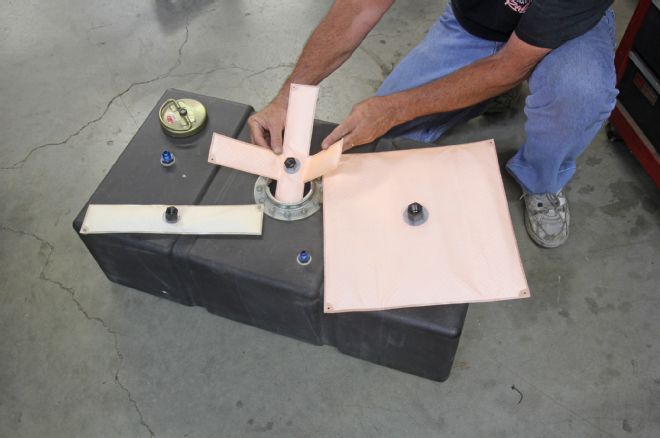
01. The HydraMat offers an easy way to improve fuel pickup efficiency for EFI systems that demand that the fuel pump always have a constant supply of fuel. The HydraMat can be used on virtually any type of fuel tank of any configuration.
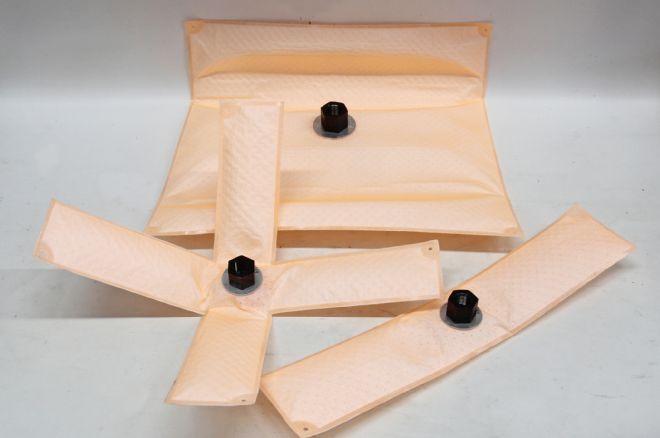
02. Holley offers the HydraMat in nine different configurations and sizes. The smallest, (lower right), is a simple strip 15x3 inches, while the largest is a 15x15-inch square. All Holley HydraMats come with a fitting in the center using either a 3/8- or 1/2-inch NPT fitting to feed the fuel pump inlet.
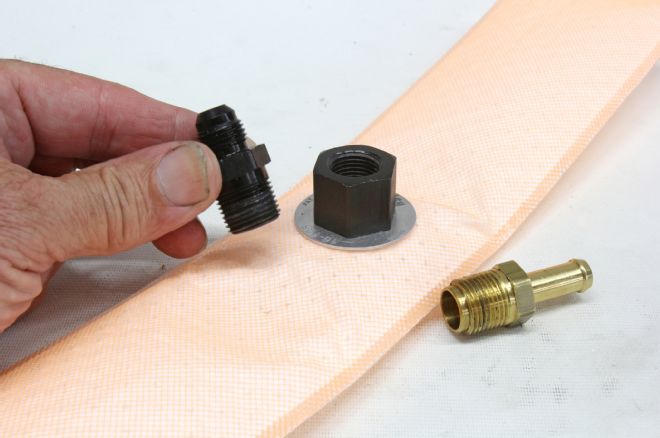
03. Depending upon the size of the mat, the center pump feed will either be a 3/8- or 1/2-inch NPT thread. In the photo is a 3/8 NPT to -6 male fitting for a braided hose or a 3/8-inch hose barb for a submersible rubber hose.
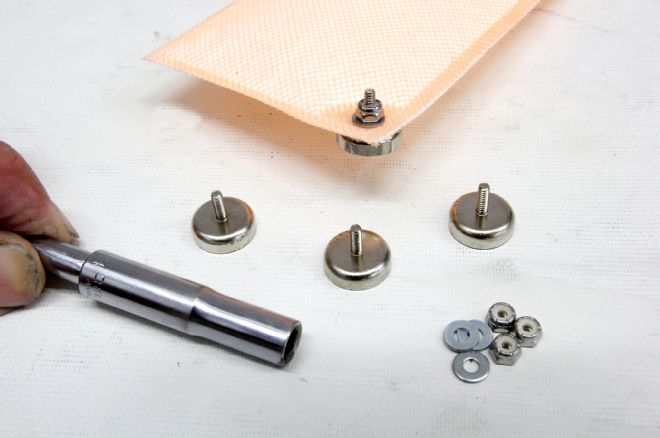
04. The HydraMat should be secured to the bottom of the tank so it does not move. Small holes in the corners of each mat are intended for small, threaded-pin magnets that secure the mat to the tank. For steel tanks, this PN 16-204 kit uses magnets with 6-32 machined studs and locking nuts to secure the mat to the tank.
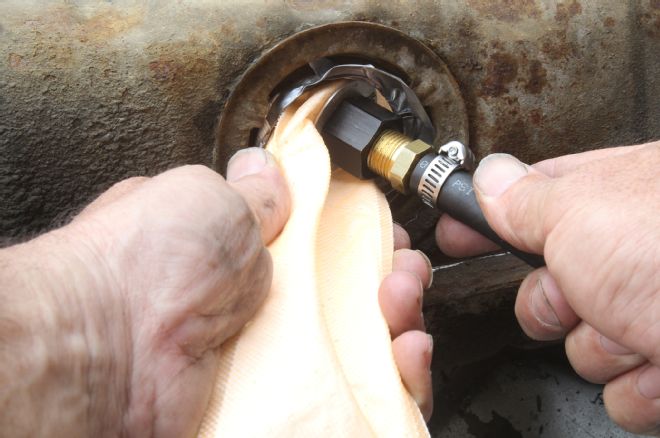
05. We managed to squeeze the small 15x3-inch HydraMat through a stock Chevelle sending unit hole gas tank. Holley suggests lining any sharp-edge tank inlets with duct tape to protect the HydraMat during installation. With a fitting, 3/8-inch fuel line, and magnets in place, we were able to squeeze this packaging to a stock Chevelle fuel tank.
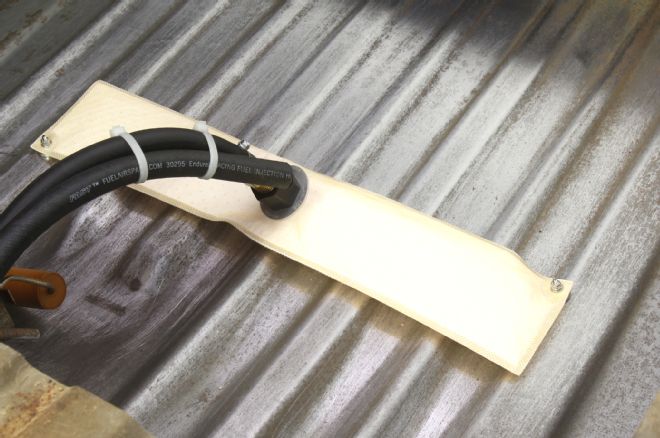
06. Here’s the small HydraMat located inside a stock Chevelle tank with the top removed so you can see how this is configured. The mat is held in place by the magnets and connected with a 3/8 rubber line to the stock fuel sending unit with a 3/8-inch return line brazed in place to complete the return, which is zip-tied to the inlet line.
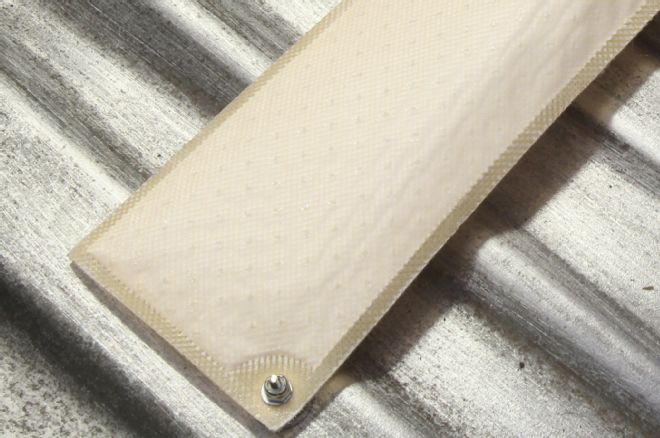
07. This tight view shows the magnets holding the HydraMat to the tank floor. These magnets are really strong and require significant effort to move so the mat will stay secure.
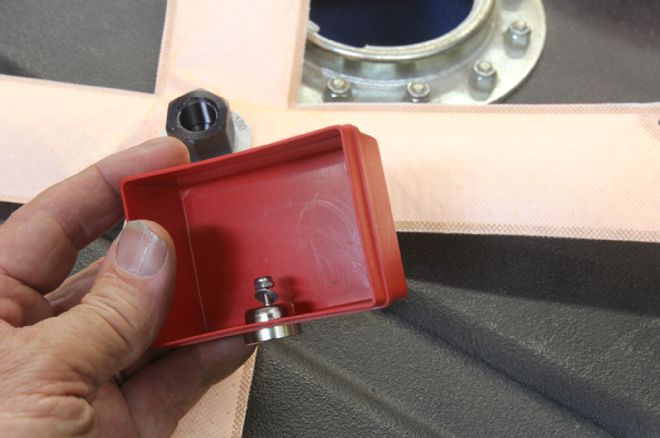
08. For plastic fuel cells, Holley sells a second magnet kit that uses the 16-204 kit on the inside, retained with very strong magnets located on the outside of the tank (PN 16-205), as illustrated by this plastic red box with the pin magnet on the inside is held in place by the magnet on the outside.
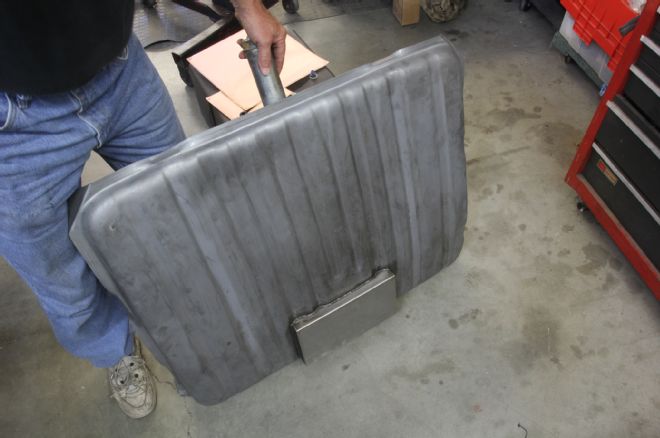
09. The HydraMat could also be used with an existing modified tank like this one that already has a reservoir installed. Because the pump is already located in the tank, a HydraMat could be a low-cost upgrade.
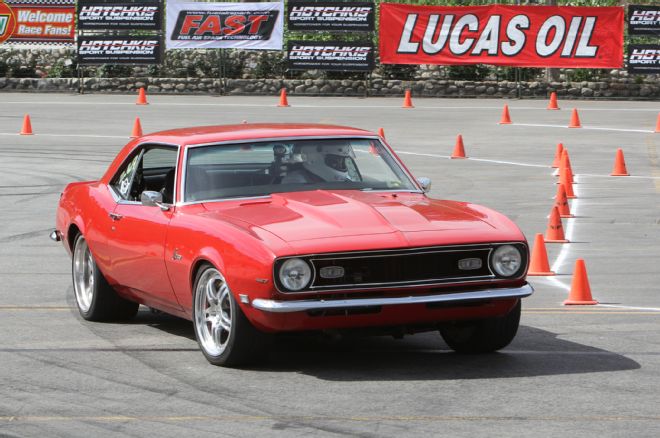
10. The whole idea for the HydraMat is to place a simple, all-inclusive fuel pickup for EFI-converted cars that is more than capable of maintaining fuel pressure during aggressive maneuvers, like those made on an autocross course, even with a low fuel level.
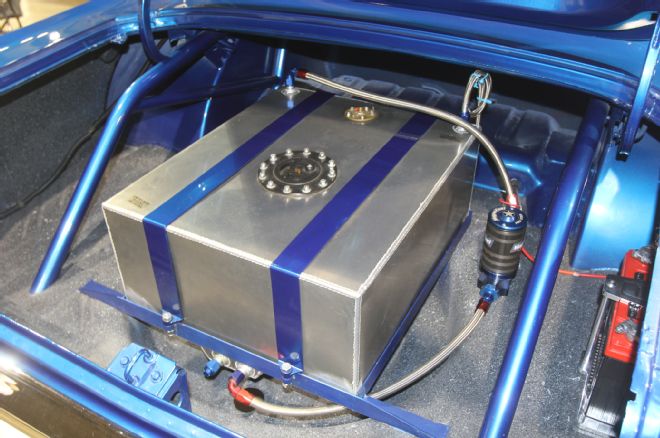
11. If the pump can only be mounted outside the tank, its best location is at or below the fuel level to minimize inlet restrictions. Larger lines leading to the pump will also improve pump efficiency. In this application, even with a HydraMat on the bottom of the tank, the pump still must pull fuel to the top of the tank, although siphoning effect will certainly help.
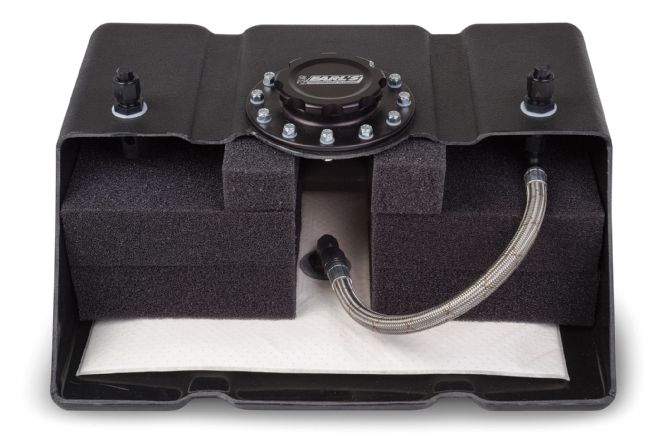
12. This cutaway shows how it would be easy to mount a HydraMat on the floor of a typical fuel cell using a -8 line to connect to the pump inlet. The weight of fuel in the foam could easily keep the HydraMat in place or Holley’s mounts could be used.